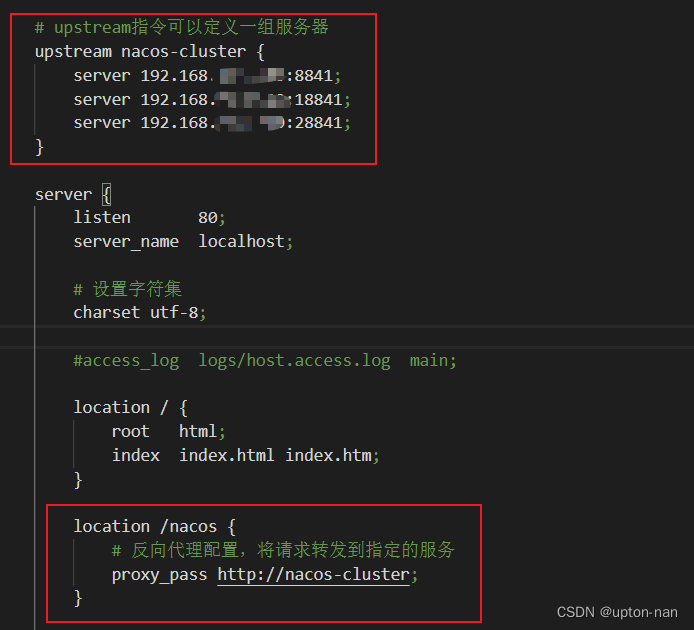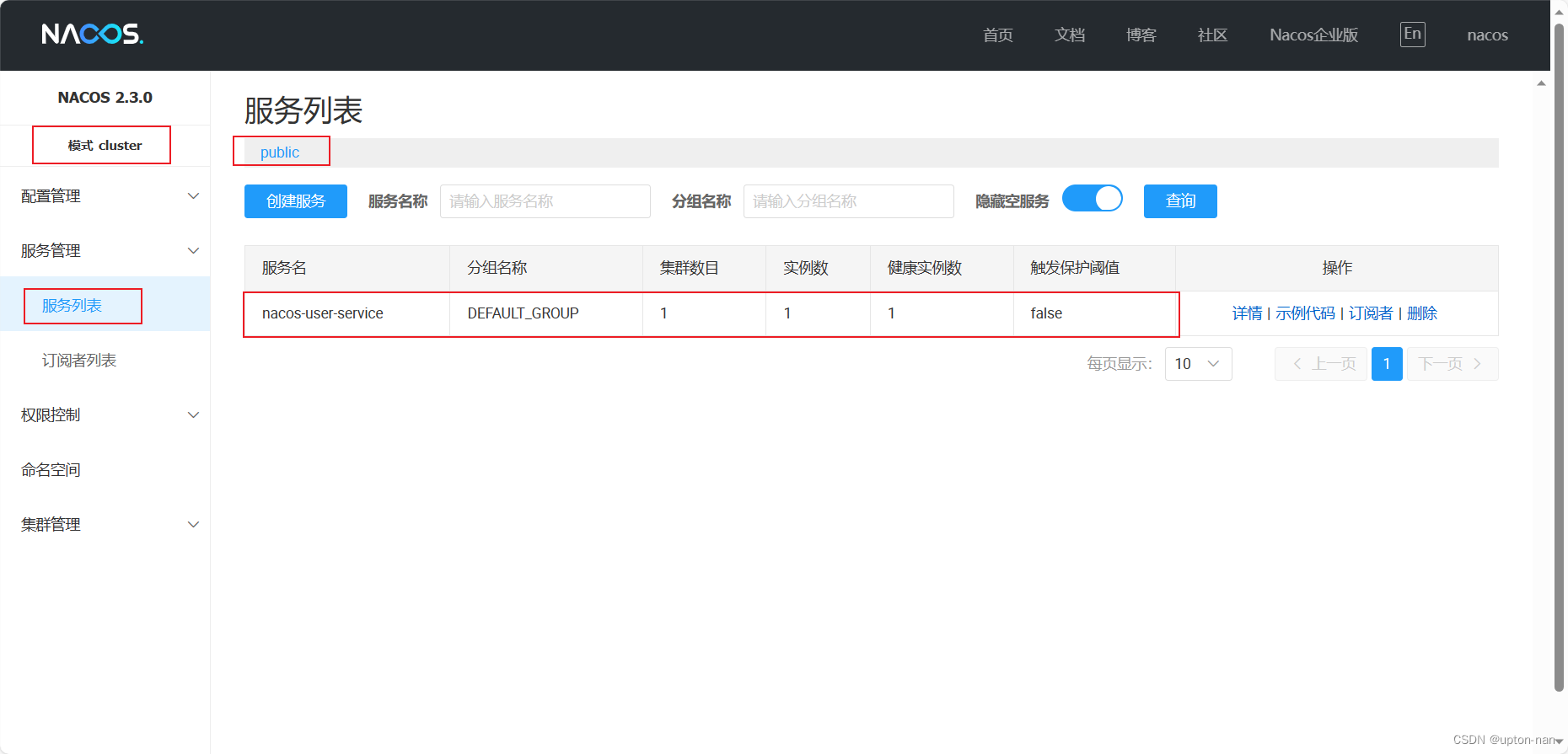如何在Ubuntu的Linux系统上搭建nacos集群
发布时间:2023年12月18日
- 官方给出的集群部署架构图

- 集群部署说明 (nacos.io)
- 3个或3个以上nacos节点才能构成集群
- 当前示例中包含3个nacos节点,同时一个负载均衡器代理3个nacos,本示例中负载均衡器可使用的是nginx
- 准备并安装好正常运行的nginx,本示例略
- 准备并安装好正常运行的MySQL数据库,本示例略
- 3个nacos节点地址信息
-
节点 ip port nacos1 192.168.xxx.xxx 8841 nacos2 192.168.xxx.xxx 18841 nacos3 192.168.xxx.xxx 28841 - 根据自己的实际情况设置,端口建议不要设置为连续的,防止nacos启动时有可能存在端口冲突,最好不同nacos的节点的端口相差有一定的步数,步数大于1002以上
-
- 开始搭建nacos集群
- 下载nacos安装包
- https://github.com/alibaba/nacos/releases

- 本示例下载的压缩包为:nacos-server-2.3.0.tar.gz
- 通过ssh远程工具将压缩包上传到Linux服务器中,然后再解压
-
tar -zxvf nacos-server-2.3.0.tar.gz 
-
- 初始化nacos的数据库脚本
- 在解压的文件中的conf文件夹中找到mysql-schema.sql,这里是nacos建立数据库的相关SQL数据,使用数据库管理工具新建一个数据库名称为nacos的数据库,并将当前mysql-schema.sql的sql文件在nacos数据库中执行,结果如下所示

- 回到Linux服务中,进入nacos的conf目录,将配置文件cluster.conf.example,重命名为cluster.conf

-
mv cluster.conf.example cluster.conf 
- 将配置文件cluster.conf修改为以下信息,其中ip地址修改为自己的服务器ip地址,端口设定为自己设定的nacos的服务端口
-
# # Copyright 1999-2021 Alibaba Group Holding Ltd. # # Licensed under the Apache License, Version 2.0 (the "License"); # you may not use this file except in compliance with the License. # You may obtain a copy of the License at # # http://www.apache.org/licenses/LICENSE-2.0 # # Unless required by applicable law or agreed to in writing, software # distributed under the License is distributed on an "AS IS" BASIS, # WITHOUT WARRANTIES OR CONDITIONS OF ANY KIND, either express or implied. # See the License for the specific language governing permissions and # limitations under the License. # #it is ip #example 192.168.xxx.xxx:8841 192.168.xxx.xxx:18841 192.168.xxx.xxx:28841
-
- 修改配置文件application.properties,添加数据库配置、开启鉴权等相关信息

-
### 是否开启鉴权功能 ### If turn on auth system: nacos.core.auth.enabled=true ### 配置自定义身份识别的key(不可为空)和value(不可为空) ### Since 1.4.1, worked when nacos.core.auth.enabled=true and nacos.core.auth.enable.userAgentAuthWhite=false. ### The two properties is the white list for auth and used by identity the request from other server. nacos.core.auth.server.identity.key=exampleNacos nacos.core.auth.server.identity.value=exampleNacos ### 默认鉴权插件用于生成用户登陆临时accessToken所使用的密钥,使用默认值有安全风险 ### 自定义密钥时,推荐将配置项设置为Base64编码的字符串,且原始密钥长度不得低于32字符。 Base64 在线编码解码: https://base64.us/ ### The default token (Base64 String): nacos.core.auth.plugin.nacos.token.secret.key=SecretKey012345678901234567890123456789012345678901234567890123456789 # mysql数据库配置信息 ### If use MySQL as datasource: ### Deprecated configuration property, it is recommended to use `spring.sql.init.platform` replaced. # spring.datasource.platform=mysql # 初始化使用的数据库为MySQL spring.sql.init.platform=mysql # 数据库连接数量 ### Count of DB: db.num=1 ### Connect URL of DB: # 连接mysql的url db.url.0=jdbc:mysql://192.168.xxx.xxx:3333/nacos?characterEncoding=utf8&connectTimeout=1000&socketTimeout=3000&autoReconnect=true&useUnicode=true&useSSL=false&serverTimezone=UTC # 连接mysql的用户 db.user.0=root # 连接mysql的密码 db.password.0=123456
- 将解压之后的nacos的文件复制3份,分别为nacos1、nacos2、nacos3
-
cp -rf nacos ./nacos1 cp -rf nacos ./nacos2 cp -rf nacos ./nacos3 
-
- 分别修改nacos的application.properties,将里面的server.port修改为指定的端口
- nacos1
-
### Default web server port: server.port=8841
-
- nacos2
-
### Default web server port: server.port=18841
-
- nacos3
-
### Default web server port: server.port=28841
-

- nacos1
- 分别给nacos1、nacos2、nacos3配置jdk环境,修改startup.sh文件

-
# 配置JDK环境,要求JDK 1.8+ export JAVA_HOME=/usr/local/project/openjdk-8 export JRE_HOME=$JAVA_HOME/jre export CLASSPATH=$JAVA_HOME/lib:$JRE_HOME/lib:$CLASSPATH export PATH=$JAVA_HOME/bin:$JRE_HOME/bin:$PATH 
- 然后分别启动nacos1、nacos2、nacos3的节点,启动脚本文件为startup.sh
-
/usr/local/project/nacos-group/nacos1/bin/startup.sh /usr/local/project/nacos-group/nacos2/bin/startup.sh /usr/local/project/nacos-group/nacos3/bin/startup.sh
-
- 访问地址http://192.168.xxx.xxx:8841/nacos/,输入默认账号密码:nacos/nacos登录可到达nacos控制台,三个节点状态都是up则说明启动成功

- 同时如果都启动成功,所有节点的端口的nacos的控制台都可以正常访问
- 下载nacos安装包
- 配置nginx的反向代理
- 默认端口占用情况
-
端口 与主端口的偏移量 描述 8848 0 主端口,客户端、控制台及OpenAPI所使用的HTTP端口 9848 1000 客户端gRPC请求服务端端口,用于客户端向服务端发起连接和请求 9849 1001 服务端gRPC请求服务端端口,用于服务间同步等 7848 -1000 Jraft请求服务端端口,用于处理服务端间的Raft相关请求 - 使用VIP/nginx请求时,需要配置成TCP转发,不能配置http2转发,否则连接会被nginx断开。 9849和7848端口为服务端之间的通信端口,请勿暴露到外部网络环境和客户端测。
-
- 根据主端口偏移量,可以计算出客户端gRPC请求服务端端口:
- 8841+1000=9841
- 18841+1000=19841
- 28841+1000=29841
- nginx监听的是80端口,则80+1000=1080
- 找到nginx的配置文件conf/nginx.conf
- 修改conf/nginx.conf的配置文件信息,添加以下配置
- 在http块内添加
-
# upstream指令可以定义一组服务器 upstream nacos-cluster { server 192.168.xxx.xxx:8841; server 192.168.xxx.xxx:18841; server 192.168.xxx.xxx:28841; }
-
- 在server块中添加
-
location /nacos { # 反向代理配置,将请求转发到指定的服务 proxy_pass http://nacos-cluster; }
-
- 在stream块用于做nacos的TCP转发
-
# stream块用于做nacos的TCP转发 stream { # upstream指令可以定义一组服务器 upstream nacos-cluster { server 192.168.xxx.xxx:9841; server 192.168.xxx.xxx:19841; server 192.168.xxx.xxx:29841; } server { # 80+1000=1080 listen 1080; proxy_connect_timeout 30s; proxy_timeout 5m; # 反向代理配置,将请求转发到指定的服务 proxy_pass nacos-cluster; } }
-


- 在http块内添加
- 启动nginx
-
sudo /usr/local/project/nginx/sbin/nginx - nginx监听的是80端口,所以需要管理员权限启动nginx
- 如果nginx启动报错类似于:nginx: [emerg] unknown directive "stream" in /usr/local/project/nginx/conf/nginx.conf:159,解决方案请参考作者当前博客链接:nginx启动报错nginx: [emerg] unknown directive “stream“ in /usr/local/project/nginx/conf/nginx.conf:159-CSDN博客
-
- 默认端口占用情况
- 浏览器访问nginx监听的端口,访问nacos,当前示例访问地址为http://192.168.xxx.xxx/nacos/

- 显示可以正常访问
- 项目中连接nacos实现服务注册和服务发现
-
server: port: 18080 spring: application: #应用的名称 name: nacos-user-service cloud: nacos: # Nacos Server 启动监听的ip地址和端口 server-addr: 192.168.163.100:80 discovery: # nacos开启鉴权之后的用户名 username: nacos # nacos开启鉴权之后的用户登录密码 password: nacos # 配置服务实例的集群名称 cluster-name: GD 
-
- 生产环境优化建议
- 实际部署时,我们最好给反向代理的nginx服务器设置一个域名,这样后续如果有服务器迁移,nacos的客户端也无需更改配置
- ?Nacos的各个节点应该部署到多个不同的服务器上,这样可以做到容灾和隔离
文章来源:https://blog.csdn.net/weixin_41926152/article/details/134983096
本文来自互联网用户投稿,该文观点仅代表作者本人,不代表本站立场。本站仅提供信息存储空间服务,不拥有所有权,不承担相关法律责任。 如若内容造成侵权/违法违规/事实不符,请联系我的编程经验分享网邮箱:chenni525@qq.com进行投诉反馈,一经查实,立即删除!
本文来自互联网用户投稿,该文观点仅代表作者本人,不代表本站立场。本站仅提供信息存储空间服务,不拥有所有权,不承担相关法律责任。 如若内容造成侵权/违法违规/事实不符,请联系我的编程经验分享网邮箱:chenni525@qq.com进行投诉反馈,一经查实,立即删除!
最新文章
- Python教程
- 深入理解 MySQL 中的 HAVING 关键字和聚合函数
- Qt之QChar编码(1)
- MyBatis入门基础篇
- 用Python脚本实现FFmpeg批量转换
- 分析木工家具封边机如何塑造结实耐用的封边
- C#设计模式教程(6):原型模式(Prototype Pattern)
- 栈和队列的实现(Java篇)
- 超详细YOLOv8验证参数、说明详解
- 鸿蒙开发之监听屏幕横竖屏切换
- API是什么?API的基础知识你知道多少
- 【apollo在springboot中运行原理】
- 如何预防[[MyFile@waifu.club]].wis [[backup@waifu.club]].wis勒索病毒感染您的计算机?
- x-cmd pkg | skate - 个人键值对存储工具
- 2023我的编程之旅-地质人的山和水
